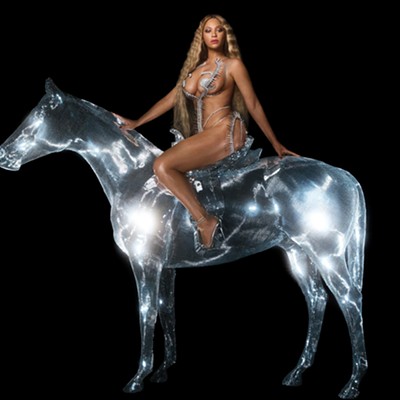There is a scene in the seminal graffiti documentary Style Wars where a one-armed artist called KASE 2 speaks about his progression from block and bubble fonts to what he calls computer rock. The stylistic change he refers to is the shift from merely marking a surface with one's name to leaving an entirely different mark -- a freer, more subjective form of expression. KASE 2, either aware or unaware of the early-1980s graffiti revolution he was on the cusp of, says, "When I really get going, I don't even think you'll be able to read it."
He meant, literally, that his tags would be unreadable. His artistic ambition drove him to rise above "readability" to expand what he was capable of communicating. That's been the leading edge of hip-hop culture since its inception, artists reveling in stylistic flamboyance to the point that they ignore, or transcend, making sense. Style Wars' footage of KASE 2 shows that it wasn't long after the birth of hip-hop that artists were already embracing free experimentation. That's no less true of rapping.
In the world of music, we're talking about an elite group of MCs whose contemporary contributors include Ol' Dirty Bastard, Kool Keith, Ghostface, MF DOOM and other lovable weirdos who blend sense and nonsense to create new textures, new styles, new ways to verbally express. Some unorthodox styles start trends, while some styles are singularities that can never be imitated. It is in this pantheon that Del the Funkee Homosapien belongs. Indeed, he may occupy his own unique place above that, as the MC who isn't content to merely create, but to continually recreate.
Del's lyrical style, though, was not born fully formed. From 1991 to '96, Del rapped for Elektra, recording I Wish My Brother George Was Here, No Need For Alarm and Future Development. The latter never saw shelves as Elektra, like so many other labels at that time, did not effectively market the music, taking a loss on each release. Early-'90s West Coast rap was, to record execs, gangsta rap -- meaning nihilistic and direct. Del, on the other hand, was positive and abstract. Nobody at Elektra realized that Del was starting a trend, soon to be followed, of rapping off the beat, rhyming within rhymes, stressing DIY originality, and always shadowboxing imaginary opponents.
After Elektra dropped him, Del teamed up with Souls of Mischief to form the Hieroglyphics crew. They rode the strength of SoM's classic '93 'Til Infinity and Del's name-making Elektra years while they built an Internet empire. Del slanged his forgotten third Elektra album online and at shows while the rest of the crew offered full-album downloads at the Hiero Web site. They did their own marketing (work Elektra and Jive never did) to good effect, priming the rap world for their classic 1998 compilation, Third Eye Vision. Del shone with a style that always lagged, fell, and tripped behind the beat, only to catch it at the last second, whip its head back and bite its own tail. Stylistically, the disc is pure excitement.
Like sonic ginger after a seriously dangerous sushi roll, Third Eye Vision cleared the violent taste left by early-'90s West Coast gangstas and left Del with a reputation to uphold. He obliged in 1999, sealing the show on Prince Paul and Dan the Automator's Handsome Boy Modeling School collaboration. The producers, both masters of mood, called in the best of the weird, and Del repped his style to the most liquid, absolutely killing the song "Magnetizing" and previewing the extreme promise of future Del and Automator collaborations.
The first such alliance, on Deltron 3030, catapulted Del above the entire rap industry and into the solar system. The beats and rhymes were parts of the same puzzle, an adventurous foray into "space-rap," and the album became possibly the last word on the topic. For years, Del had been rapping as if he were from another planet. This time, he was fully out of this world, exploring territory that previously had been mined by only Kool Keith. Keith's album Dr. Octagon (also Automator-produced) was a stroke of spacey genius, but Del's psyche here was more stable. Indeed, while Keith followed his classic with porn-rap concept albums and schizophrenic ramblings, Deltron 3030 showed that Del was crazy like a fox, always on the outside of his spacey persona, never confused or half-stepping. Nor was he being strange for the sake of strangeness: 3030 was an album that expressed his genuine feelings of being out of step with the status quo. Faced with his own successes, he had come to the honest conclusion that he was alien to contemporary styles.
2000 also saw the release of a new solo album, Both Sides of the Brain. Unlike 3030, this one was strange to a fault, Del trading lasers and spaceships for rhymes about video games and personal hygiene. The combination of spitting about life's forgettable minutiae with purposefully annoying beats proved too much for some. On 3030, Automator gave Del beats of supreme tech-style smoothness, uninhabited Death Stars of sound, bleeps and blorps over post-apocalyptic windswept cityscapes. Both Sides of the Brain had Del rhyming like a hyperactive teenager over grating samples of sirens and alarm clocks. Not everyone's cup of tea.
He followed that, though, with a 180 of sorts. In 2001, Del teamed up with Automator and Blur's Damon Albarn to actively court fame, forming the comic-book-zombie crew Gorillaz. The resulting album was a highly accessible look into what is or is not an image, a meditation on the authority of authorship. Haters called it a gimmick, but the self-titled Gorillaz sold millions of records and, to the shock of many, yielded Grammy nods and a concert DVD.
Del reunited with the Automator one more time for his second genre mash-up under the Handsome Boy Modeling School moniker. The 2004 album White People fared well, and can only be faulted for being too ambitious in its attempt to blend indie and mainstream rock with underground rap.
From the beginning, Del has staked his entire reputation on the simple claim that, when you listen to a Del album, you won't have heard anything like it before. Flying in the face of familiarity, and sometimes marketability, he serves as a reminder that hip-hop is about reinventing the wheel while staying true to your own interpretation of what's real. He's stayed true to his spirit of individuality while exploring and even inventing new rap styles, and for the amount of successful chances he's taken so far in his career, he stands alone with his mind and career intact, still one step ahead of the curve.
Del the Funkee Homosapien at Fat Tuesday's with Zack Hendrix, Bukue One DJ Parafyn, Larue and DJ Kruk Serendipity on Tuesday, April 25, at 8 pm. Tickets: $15; $20, at the door. Call 326-4842.















